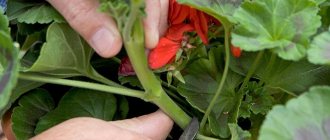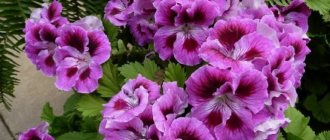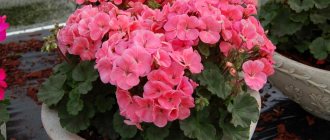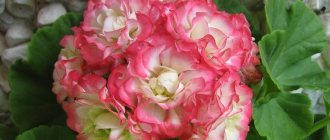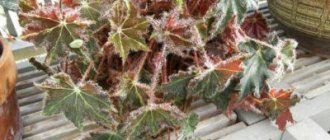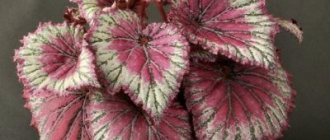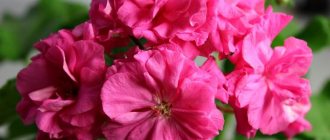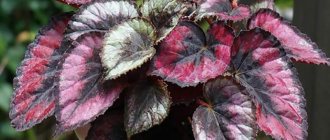Instagram VK
Tel. 8-996-686-71-22 (VIBER, WhatsApp). Email: [email protected]
Cvetovod86 cuttings and flower seedlings
Search
Cart / 0 ₽ 0
Cvetovod86 cuttings and flower seedlings
Instagram VK
Cart / 0 ₽ 0
350 ₽
Royal Pelargonium 'Rimfire'.-rooted cuttings
SKU: 3093 Category: pelargonium Tags: Royal pelargonium 'Rimfire'., Royal pelargonium 'Rimfire'. stalk
- Description
- Reviews (0)
Royal or large-flowered pelargonium. Forms well and responds well to pinching. Vertical growth. The leaf is green, lobed, may be serrated, and is often covered with hairs. The bush forms a head of large flowers (up to 10 cm in diameter). Wintering is required at a temperature of 10-15 degrees, for 1.5-2 months, otherwise flowering will be sparse or not at all.
Royal Pelargonium 'Rimfire' - rich burgundy, almost black petals with a fiery red border.
Pruning royal geraniums for lush flowering
To form a beautiful geranium bush and achieve lush flowering, it is necessary to prune it on time. There are 3 types of it: main, pinching and autumn.
The main pruning of the plant is carried out after the end of the dormant period - in early March. The shoots are shortened with a sharp, disinfected knife or pruning shears by 1/3 of the length.
The cut is made at the base of the leaves so that the top bud “looks” outward and not inside the bush. This will allow you to form a lush, beautiful bush that will grow in width.
After pruning, it is recommended to feed the plant with fertilizer with a high nitrogen content to increase green mass.
All cuts must be sprinkled with crushed activated carbon so that they do not rot and heal faster.
Pinching of shoots is carried out throughout spring and summer. The first pinching of the planted cuttings is necessary when it reaches a height of 20 cm. In this case, only the upper growth point is removed with clean fingers so that lateral shoots begin to form.
When the new branches have grown sufficiently, they can also be pinched so that the bush becomes wider and denser. The pinching procedure can be carried out several times during the summer.
Autumn pruning is carried out in early October and consists of removing faded flower stalks, yellowed leaves and dying shoots.
Planting and transplanting
Rooted cuttings are planted in small plastic pots with a diameter of 8-10 cm. The pot must have several drainage holes so that water does not stagnate in the soil and can drain into the pan.
At the bottom of the pot it is necessary to pour a drainage layer of broken bricks, shards or expanded clay. To plant geraniums, you need fertile and light soil. The best results are obtained from a mixture of crushed peat, sand and humus.
All components are taken in equal parts. You can use a commercial soil mixture for flowering plants if it contains peat. The mixture for planting geraniums should be moist.
The rooted and already growing cuttings are carefully removed from the container with sand in order to reduce the risk of damaging the root system. Its roots are straightened in a pot and covered with prepared soil mixture. After planting, the soil is slightly compacted and carefully watered along the edge of the pot.
It is recommended to replant royal geraniums annually.
An old pot is used for replanting. Carefully remove the plant and shake off the old soil from the roots. After this, large and long roots are cut by 1/3 so that the entire root system of the plant is approximately the same length. After this, the plant is placed in a washed old pot and the roots are covered with fresh soil mixture.
Simultaneously with pruning the roots, it is necessary to trim the above-ground part of the plant so that it matches the root system. All shoots are shortened by 1/3, and weak, thin and elongated branches are removed.
Tips for caring for pelargonium
This variety of geranium does not tolerate summer heat. The optimal temperature for it is the range from 18 to 25ºС. The plant develops best when the temperature drops at night to 15ºC.
During the cold period, geraniums need a cool winter . This will ensure buds set in the spring and abundant flowering until the end of summer. During the rest period, the temperature should be maintained within 13-15ºС. It is not recommended to keep the plant at room temperature in winter. The lack of wintering in royal geraniums may be the reason why the plant does not bloom.
Royal geraniums love indirect light.
Geraniums cannot be placed in direct sun; shading is necessary. She also does not tolerate partial shade or shade. With a lack of light, its leaves become smaller and its shoots become elongated.
During the growing season and flowering, the plant needs to be watered abundantly. Typically, in summer, geraniums are watered twice a week. Between waterings, the top layer of soil should dry out a little.
Do not water geraniums with cold water. Water for irrigation should be 2-3 degrees warmer than the surrounding air.
During the dormant period, watering is significantly reduced. Water so that the soil in the pot always remains slightly moist. An abundance of water in the soil in winter is unacceptable, as it quickly leads to root rot.
Geraniums are fertilized twice a month in spring and summer. Use complex liquid fertilizers for flowering plants. The fertilizer is diluted with water and applied to moist soil after watering.
You can read more about caring for other types and varieties of pelargonium here.
Diseases and pests
Royal geranium is a capricious plant, susceptible to many infections. It especially suffers from fungal diseases, the development of which is caused by improper watering. The most common types of rot are root and stem rot, as well as rust.
If watering is too frequent and water stagnates in the soil,
root rot .
The onset of the disease cannot be determined. Then, as it progresses, the leaves turn yellow and fall off, and the shoots die.
Transplanting into new soil and treating with antifungal drugs will not help here.
It is best to cut the apical cuttings from healthy shoots and root them. The diseased plant is destroyed.
Stem rot , or "blackleg", appears as blackening at the bottom of the stem. The disease spreads quickly and soon covers the entire plant. It is caused by improper watering and too high humidity. A diseased plant cannot be treated. It is destroyed by first cutting healthy cuttings for rooting.
Rust can be easily recognized by the brown round spots on the leaves. This disease develops in a humid environment. To combat it, you need to trim and destroy all leaves and shoots with spots, and spray the plant itself with antifungal drugs. The treatment is repeated several times until the pathogen is completely destroyed.
In summer, pests can settle on geranium bushes: whiteflies, mites and aphids. These pests feed on plant sap and can cause irreparable damage to the appearance of geraniums. To destroy them, it is necessary to use only special purchased insecticidal preparations.
What to do if geranium does not bloom
The reason for the lack of buds in geraniums can be many factors. To make a plant bloom, you can use some techniques:
- Proper pruning of the plant;
- Feed the flower with potassium fertilizers once every 2 weeks;
- Limit watering - moisten the soil only after its top layer has dried;
- A flower pot that is too large will contribute to the growth of green mass, while a small one will harm the geranium. If the problem is in the flowerpot, the flower should be replanted.
- Lack of light may be the reason for the lack of flowers. Pelargonium needs bright, but diffused lighting, without exposure to scorching sunlight. In addition, the plant is afraid of wind and rain, so it should only be placed in the house or on a glazed balcony.
- For abundant flowering of royal geranium, a cool winter is required, with a temperature no higher than 12 degrees and minimal watering.
- If the pelargonium is crowded or shaded by other flowers, it will not bloom either. In this case, the plant must be planted and given enough free space.
Now you know everything about caring for and propagating royal geraniums at home.
